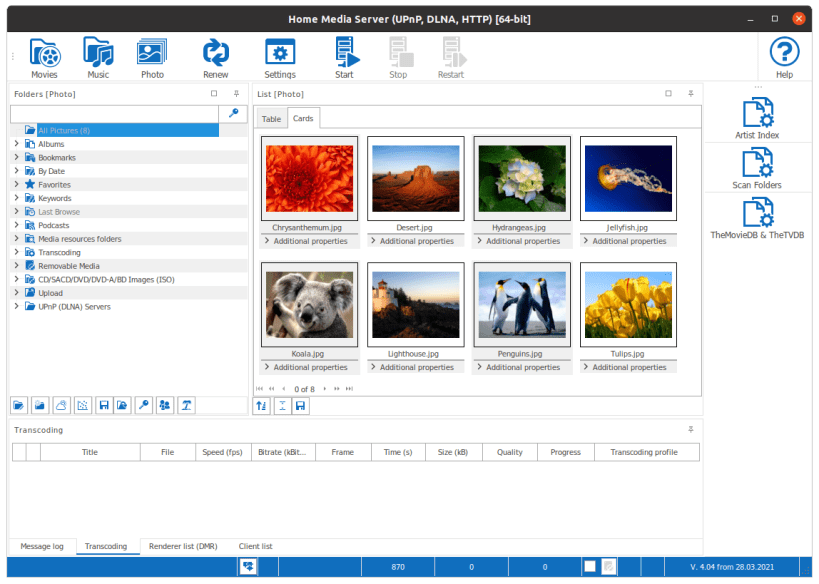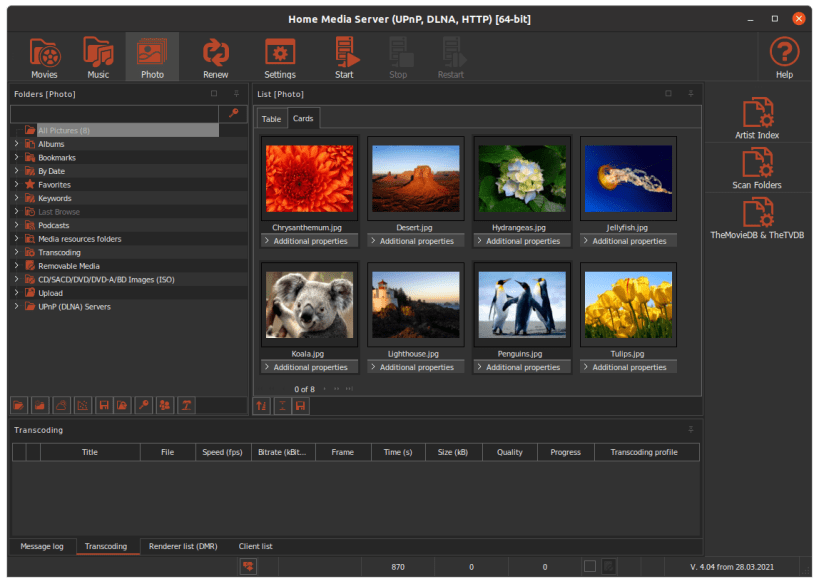





Home Media Server (UPnP, DLNA, HTTP) - program, which provides media resources (photographs, audio and video files) on your computer to other UPnP (DLNA) devices in the home network, for example, Philips TVs (SimplyShare), Sony TVs, Samsung TVs (AllShare), LG TVs (SmartShare), Toshiba TVs, Sony Playstation, XBOX 360 (One), WD TV Live, iPad/iPhone/iPod, Apple TV (AirPlay), Chromecast (Google Cast), mobile and PDA devices.
Software contains a transcoders audio and video files, allows you to convert media resources in a format that is supported by the playback device. You can also convert the aspect ratio of video files to a format screen playback device and to choose audio tracks, subtitles.
Software supports special video folders Music (Visualization) and Photo (Slideshow).
Software supports external and internal subtitles, can impose subtitles (2D and 3D) during the process of transcoding.
Software supports DMR (Digital Media Renderer) devices control, mutli-room systems Sony Party Streaming, Yamaha MusicCast, Sonos, Denon (Heos) and Airplay 2, you can use the feature "Play to" to single device and group of devices (multiple devices).
Software supports scripts to load the data from internet database of movies (IMDb, IMDb-API, TheMovieDB, TheTVDB.com included).
Software supports Web-navigation with HTML5 player on devices without DLNA (UPnP) support.
Software supports Digital Media Renderer (DMR) emulation for Airplay and Google Cast devices.
Software supports customizing structure of media resources for each device, dynamic folders (the items in the folder are created with a script).
Software supports Digital Media Controller (DMC) functionality.
You are about to open
Do you wish to proceed?
Thank you for your report. Information you provided will help us investigate further.
There was an error while sending your report. Please try again later.
Snaps are applications packaged with all their dependencies to run on all popular Linux distributions from a single build. They update automatically and roll back gracefully.
Snaps are discoverable and installable from the Snap Store, an app store with an audience of millions.

Snap is available for Red Hat Enterprise Linux (RHEL) 8 and RHEL 7, from the 7.6 release onward.
The packages for RHEL 7, RHEL 8, and RHEL 9 are in each distribution’s respective Extra Packages for Enterprise Linux (EPEL) repository. The instructions for adding this repository diverge slightly between RHEL 7, RHEL 8 and RHEL 9, which is why they’re listed separately below.
The EPEL repository can be added to RHEL 9 with the following command:
sudo dnf install https://dl.fedoraproject.org/pub/epel/epel-release-latest-9.noarch.rpm
sudo dnf upgrade
The EPEL repository can be added to RHEL 8 with the following command:
sudo dnf install https://dl.fedoraproject.org/pub/epel/epel-release-latest-8.noarch.rpm
sudo dnf upgrade
The EPEL repository can be added to RHEL 7 with the following command:
sudo rpm -ivh https://dl.fedoraproject.org/pub/epel/epel-release-latest-7.noarch.rpm
Adding the optional and extras repositories is also recommended:
sudo subscription-manager repos --enable "rhel-*-optional-rpms" --enable "rhel-*-extras-rpms"
sudo yum update
Snap can now be installed as follows:
sudo yum install snapd
Once installed, the systemd unit that manages the main snap communication socket needs to be enabled:
sudo systemctl enable --now snapd.socket
To enable classic snap support, enter the following to create a symbolic link between /var/lib/snapd/snap and /snap:
sudo ln -s /var/lib/snapd/snap /snap
Either log out and back in again or restart your system to ensure snap’s paths are updated correctly.
To install Home Media Server, simply use the following command:
sudo snap install home-media-server
Browse and find snaps from the convenience of your desktop using the snap store snap.

Interested to find out more about snaps? Want to publish your own application? Visit snapcraft.io now.